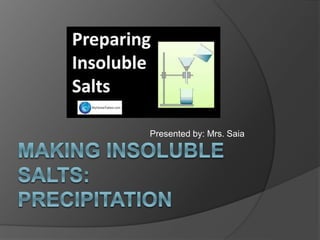
Making insoluble salts week 3
- 1. Presented by: Mrs. Saia
- 2. Review last lesson Preparing soluble salts A pure, dry sample of a soluble salt can be prepared in two ways. 1 Method one add excess insoluble substance (base) to warm acid filter off excess base evaporate filtrate to half volume cool to allow crystals to form filter off the crystals 2 Method two add alkali to acid, or vice versa, in the presence of an indicator until the indicator changes colour repeat the process without the indicator, or remove the indicator using charcoal evaporate the solution to half volume cool to allow crystals to form filter off the crystals You can dry the crystals by placing it in a desicator, in a low temperature oven, or between two sheets of filter paper.
- 3. Objectives Demonstrate knowledge and understanding of the preparation of insoluble salts by precipitation Suggest a method of making a given salt from a suitable starting material, given appropriate information
- 4. To make an insoluble salt, two soluble salts need to react together in a precipitation reaction. For this purpose we need to know which salts are soluble and which are insoluble All nitrates are soluble All sodium, potassium and ammonium salts are soluble All chlorides are soluble except lead and silver All sulfates are soluble except lead, calcium and barium All carbonates are insoluble except sodium potassium and ammonium
- 5. Insoluble salt Using information from prevoius slide lets find out if the salt is soluble or not Sodium chloride Magnesium sulfate Ammonium nitrate Lead chloride Silver nitrate Calciun carbonate Potassium sulfate Barium chloride Iron sulfate Barium sulfate Lead nitrate Ammonium chloride Calcium chloride
- 6. Choosing the reactants/reagent We can see that silver chloride is an insoluble salt. It can be made by reacting a soluble silver salt with a soluble chloride salt. Which silver salt is soluble? Silver nitrate Which soluble chloride we may use Many: NaCl, MgCl2, HCl and any of chloride except a few , one we just want to make
- 7. Making silver chloride Silver nitrate and sodium chloride are both soluble. When their solutions are mixed together, soluble sodium nitrate and insoluble silver chloride are made: silver nitrate + sodium chloride → sodium nitrate + silver chloride AgNO3(aq) + NaCl(aq) → NaNO3(aq) + AgCl(s) The reaction just takes place between silver and chloride ions actually to make silver chloride insoluble salt. The silver chloride appears as tiny particles suspended in the reaction mixture - this is the precipitate. The precipitate can be filtered, washed with water on the filter paper, and then dried in an oven.
- 8. Method Mix together two suitable solutions (see above). Use filtration to separate the precipitate as a residue from the solution. Wash the precipitate with distilled water while it is in the filter funnel. Leave the washed precipitate aside or in a warm oven to dry. it with distilled water. Reasons for each step Filtration separates insoluble substances from liquids and solutions. The precipitate is insoluble in water, so any remaining contaminating solution can be removed by washing
- 9. Making silver chloride Mix together two suitable solutions. Use filtration to separate the precipitate as a residue from the solution. Wash the precipitate with distilled water while it is in the filter funnel. Leave the washed precipitate aside or in a warm oven to dry. it with distilled water.
- 10. What is Precipitation Reaction A chemical reaction occurring in an aqueous solution where two ions from two different solutions combine, resulting in the formation of an insoluble salt”. These insoluble salts formed in precipitation reactions are called precipitates. Precipitation reactions are usually double displacement reactions involving the production of a solid form residue called the precipitate. These reactions also occur when two or more solutions with different salts are combined, resulting in the formation of insoluble salts that precipitate out of the solution.
- 11. Examples of precipitation Some more examples of chemical equations of on precipitation reaction are as below AgNO3(aq) + KCl(aq) → AgCl(s) + KNO3(aq) MgCl2(aq) + Na2CO3(aq) → MgCO3(s) + 2NaCl(aq) Chemistry of precipitation reactions These reactions are called double displacement reactions where ions of two soluble salts displace each other AB + CD → CB + AD
- 12. Understanding ionic equations AB(aq) + CD(aq) → AD(aq) + CB(s) A+(aq) + B-(aq) + C+(aq) + D-(aq) → A+(aq) + D-(aq) + CB(s) C+ (aq)+ B- (aq) → CB (s)